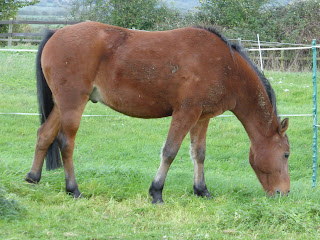All
animal
cells are surrounded by tissue fluid. This is the source of the water, oxygen and
nutrients needed by the cells but it also removes any substances excreted from
the cell. As I explained in my blog
about the Lymphatic
System, the tissue fluid is where the exchange of substances happens
between the cells and the blood
vessels and lymph!
Cells
need water because almost all processes that are essential to life take place
in a solution! Oxygen and nutrients are necessary to produce energy. All these elements are carried to the cells
in the blood. Water and nutrients enter
the blood from the digestive
system, oxygen enters through the respiratory
system.
Horses
(and all living things) need usable energy to move, grow, reproduce and
repair. Energy cannot be created (or
destroyed) it is only changed from one form to another (the first law of
thermodynamics). Energy exists in many
forms; including chemical, electrical, nuclear, heat, light, and mechanical.
For
all living things, energy is obtained
from food, for a horse this is usually grass, hay or supplementary food. How is the energy from food made available
for the horse to use for these processes? The process is called cellular respiration and
it occurs in every
living cell.
In
my blog about cells a couple of weeks ago I mentioned that mitochondria supply
energy to the cell.
The
form of energy used to fuel the biological processes mentioned above is ATP
(adenosine triphosphate) but very little is stored in the body. In fact, at any one moment the body only has
enough ATP to keep it alive for 1 second!
So, ATP is continuously produced through cellular respiration, and there
are 2 types: -
- Anaerobic
respiration - is when energy is transferred from food to ATP without oxygen. In this process food molecules are only
partly broken down, not fully to result in carbon dioxide. Glucose in the food molecules is broken down
in to pyruvate (the process is called glycolysis) and then in animals the
pyruvate is converted into lactate or lactic acid (lactate fermentation). Lactic
acid build up is what causes us to have stitch if we don't breathe properly
when doing sitting trot!
- Aerobic
respiration - is when the glucose is broken down using oxygen, this happens in a number of stages to limit
the amount of heat produced. As the food
molecules are broken down the energy released is used to produce ATP . Aerobic respiration can produce a much larger
number of ATP molecules than anaerobic
respiration.
NB
- a molecule is a small particle.
The
stages of cellular respiration:-
1.
Glycolysis & Fermentation - occurs in both anaerobic and
aerobic respiration, so can take place with or without oxygen.
2.
The Krebs Cycle - takes place in the mitochondria of the
cell and requires oxygen.
3.
The Electron Transport System - also takes place in the
mitochondria and requires oxygen.
Once
the energy from food has been converted to ATP it can be used to fuel other
processes performed by the cells eg: muscle contraction or to move substances between
cells such as glucose reabsorption in the kidneys.
Have you seen this week's video 'Tommy and the scary rug' on my You Tube channel?
Horse Life and Love. Please check it out and SUBSCRIBE.
You can also follow me on Facebook, Instagram
and Twitter for updates on Chesney, Basil, Tommy and Daisy.
Until next time!
Jo
















